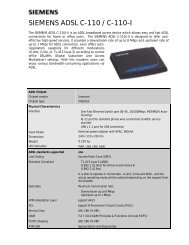Quick Start Guide SIEMENS ADSL C-110 ADSL Router
Quick Start Guide SIEMENS ADSL C-110 ADSL Router
Quick Start Guide SIEMENS ADSL C-110 ADSL Router
Create successful ePaper yourself
Turn your PDF publications into a flip-book with our unique Google optimized e-Paper software.
Domain name system. This is not an actual internet protocol, but a system for translating<br />
node names (for example www.nasa.org) into numerical addresses (for example<br />
192.168.2.1).<br />
DSL<br />
Digital Subscriber Line. Network Technology that transmits using a broad bandwidth over<br />
short distances using traditional telephone copper pairs. There are four types of DSL: <strong>ADSL</strong>,<br />
HDSL, SDSL and VDSL. Each of these uses two specific devices (similar to modems) at each<br />
end of the transmission. As most <strong>ADSL</strong> technology does not use all of the bandwidth available<br />
on the copper pair, there is space for a voice channel (for example: for normal telephone<br />
calls). See also <strong>ADSL</strong>, HDSL, SDSL and VDSL.<br />
FTP<br />
File Transfer Protocol. Principal element of the group (TCP/IP) of Internet protocols, used to<br />
transfer files from Internet servers to user computers.<br />
IPoA (RFC 1577)<br />
Classical IP over ATM.<br />
ISP<br />
Internet Service Provider. Company that manages Internet access. It is possible to access the<br />
Internet by connecting your computer (via a modem or router) to an ISP server, using special<br />
T1 telephone lines. A peer-to-peer (point-to-point) connection is used with the bandwidth of<br />
1.5 Mbps divided into 24 channels of 64 kb each. The larger ISPs may have several T1 lines.<br />
ISPs often offer additional services such as hosting & housing, e-commerce solutions and support<br />
to their customers.<br />
LAN<br />
Local Area Network. Network or group of network segments confined to a building or campus<br />
that connects computers and peripherals (such as printers, faxes and scanners) installed at<br />
the same location (for example: same building, including on different floors) or at neighboring<br />
locations (for example: two adjacent buildings). LANs usually work at high speed, for<br />
example: Ethernet has a data transfer speed of 10 Mbps or 100 Mbps in the case of Fast<br />
Ethernet. Compare WAN.<br />
MAC<br />
Media Access Control. The MAC is a radio control protocol in a wireless LAN (WLAN) network<br />
card. It corresponds to level 2 – OSI reference model data link layer. IEEE standard 802.11<br />
specifies the MAC protocol for the division of physical resources, formats and the addressing<br />
of packets and identification of errors.<br />
21



